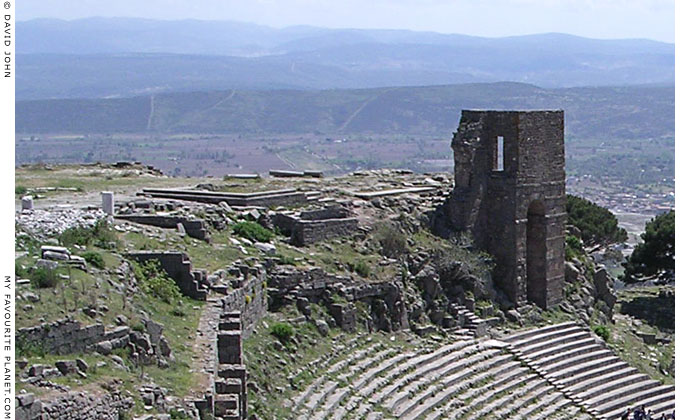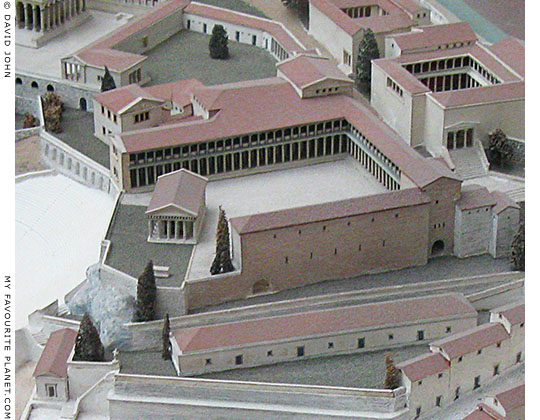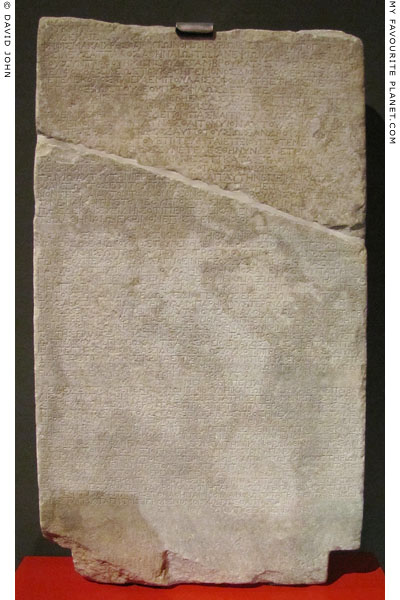|
|
|
| My Favourite Planet > English > Middle East > Turkey > Pergamon > gallery 1 |
| Pergamon gallery 1 |
Pergamon |
 |
 |
20 of 37 |
 |
 |
|
| |

Pergamon Acropolis: the site of the Sanctuary of Athena Nikephoros, left of the Byzantine tower. |
The sanctuary and temple of Athena Polias Nikephoros (Athena of the City, Bringer of Victory), which stood directly behind and above the theatre of the acropolis, was one of the oldest religious centres of Pergamon, and one of the most important, particularly during the time of the Attalid kings. The sanctuary included the famous Library of Pergamon.
See photos and information about the temple and sanctuary, the remains of which are now in the Pergamon Museum, Berlin, on gallery 2, pages 20-22. |
|
|
| |

A scale model of the Sanctuary of Athena Nikephoros in the Pergamon Museum, Berlin.
Model by H. Schleif, reconstructed by K. Stephanowitz in 1965.
See also gallery 1, page 4. |
| |

Marble stele inscribed with letters of Attalus II and Attalus III
set up in the Sanctuary of Athena Nikephoros. 150-133 BC.
Excavated in 1880 and 1883 in the north stoa of the Sanctuary of Athena.
Height 85 cm, width at top 44 cm, width at bottom 48.5 cm, depth 8.5 cm.
Antikensammlung Berlin (SMB). Inv. No. IvP 248.
|
At the top of the stele is the final clause of a decree by the people of Pergamon ordering that it should be incorporated into the city's sacred laws and be valid for all time. Below are three royal letters, each dated to the year and the day, and recording the names of the bearers of the messages. The first letter was written by Attalus II in 141 BC and the other two by Attalus III in 135 BC. They deal mainly with the appointment of close relatives of the Attalid royal family to prominent priesthoods.
Attalus III also ordered that in memory of his recently deceased mother Stratonike (Στρατονίκη, circa 200 - circa 138-135 BC), her god Sabazios (Σαβάζιος) should be worshipped alongside Athena Nikephoros, and that his cousin Athenaios should be appointed as the god's hereditary priest.
Stratonike may have brought the worship of Phrygian and Thracian sky god Sabazios to Pergamon from her birthplace in Cappadocia when she married Eumenes II, the father of Attalus III. This inscription is one of the earliest mentions of the worship of Sabazios at Pergamon, and some scholars believe that the cult may have spread from here to other Greek and Roman cities, where he was identified with Zeus and Dionysus.
Inscription IvP I 248, OGIS 331. See epigraphy.packhum.org/text/301890 at The Packard Humanities Institute. |
|
|
 |
|
|
|